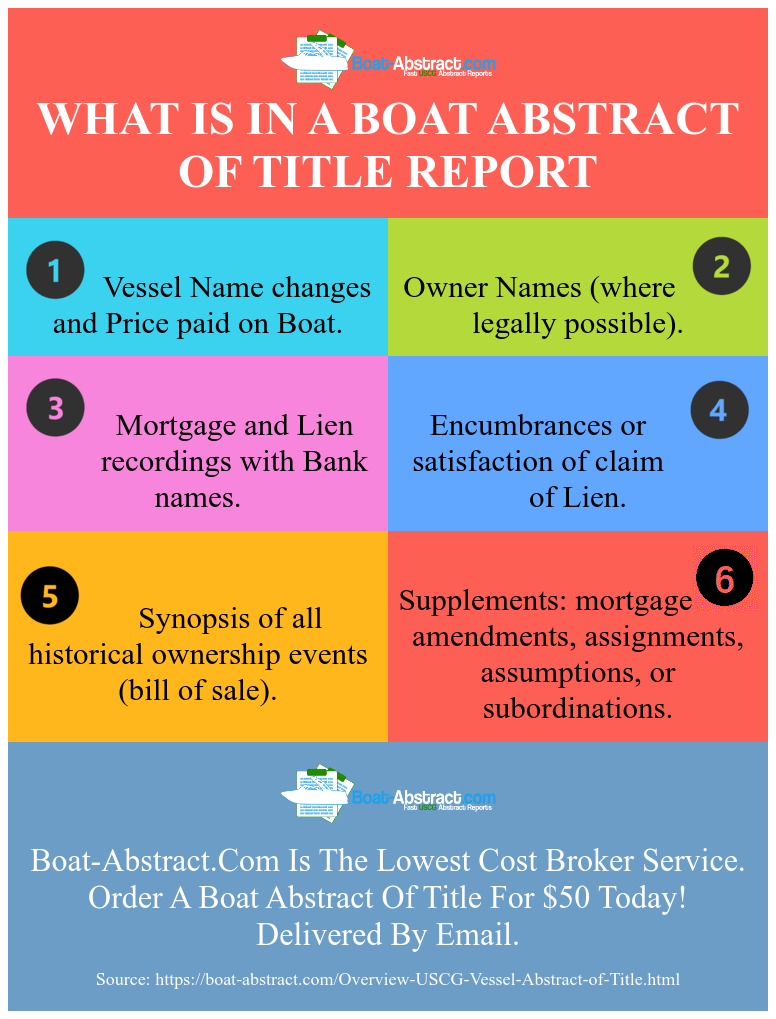What is a Boat Title Abstract for a USCG Documented Boat?
Table of Contents
In the United States of America, each kind of property is titled in different ways, like real estate is titled at the county courthouse, cars are state-titled at MVA or DMV, and airplanes are federally registered with the FAA. Boat Title Abstract is the report that gives the history of the documented vessel.
Vessel documentation is national form registration that serves as the identity for a vessel in its international purposes, especially in the matters of trade between states.
Boats can be registered in two ways:
1-With the local state agency (“State Titling”),
2-Or federally registered with the U.S. Coast Guard (“USCG Documentation”).
In both scenarios, the owner of the boat receives proof of title to the vessel. This proof is either a USCG Certificate of Documentation or a state-issued title.https://www.youtube.com/embed/rQKJctH9BaA
Which boats can be Coast Guard Documented?
Only the boats that are owned by a US citizen and weigh more than 5 tons can be Coat guard documented. Boats over 25 feet generally qualify for the documentation regardless of their weight. Smaller boats like tenders and dinghies, mostly do not qualify for the documentation. They must be state titled.
Boats over 25 feet can be both Coast Guard documented at the federal level as well as with the local state agency. The National Vessel Documentation Centre (NVDC) handles all the formalities of the Coast Guard documentation.
Is it necessary for a vessel to be documented?
Vessels weighing more than 5 tons and active in the navigable waters of the US or Exclusive Economic Zone (EEZ) must be documented unless it is exempt from documentation by law.
How does documentation effect vessel travel in international waters?
Most of the states allow only registered boats to travel on their water for a specific period, however, each state has its own rules, therefore it is important that you check the documentation rules before you enter a state.
Once a vessel has been documented, it stays documented for a lifetime. Which means that when this vessel is sold to a new owner, the new owner must update all the documentation information of the vessel, however, the ID of the vessel remains unchanged. The owner can remove the USCG or the state title if he wants to, in such a case the new owner will not need to maintain any documentation of the vessel.
How can the Abstract of Title be helpful?
Since buying a boat is always a big financial investment, it is best practice to have complete knowledge about the legal formalities of the boat. You don’t want to spend your money on an illegal boat. Therefore, the Abstract of Title will help you to know about the complete history of the vessel as well as its documentation.
This information becomes extremely useful when dealing with liens, this abstract will also give you knowledge about any liens to the boat that can hinder your purchase and can cause problems for you. Once you buy the boat, as the owner of the boat you will have to deal with all the liens filed against the vessel. In some cases, the owner has to pay thousands of dollars to clear the vessel from liens. So, make sure that you are not buying any controversial vessel.
What is Abstract of Title?
An Abstract of Title contains all the information about the documentation, history, and background of the vessel that you are buying. The US Coast Guard vessel documentation Abstracts of Title are the only media that contain all the information about the owners, liens, and other background information that is necessary for you to know before investing in a vessel.
What does the Abstract of Title contain?
Below are some documents that make up the Abstracts of Title:

An Abstract of Title contains the following information:
- Vessel data
In Abstract of the title, you will not typically find vessel’s model, tonnage or dimensions rather the place and year the vessel was built, current and previous vessel identification titles, and the documentation number officially assigned by the Coast Guard.
- Ownership information
It will include all the current owners including the single persons, legal entities and multiple people like corporations, limited liability companies, partnerships. The abstract also contains the previous ownerships transfer details.
The ownership transfer details will be a complete chain of all the previous owners and the transfer details from the date the vessel as made to the last purchase.
- Liens and Mortgages
The Coast Guard documentation has no information regarding mortgages and liens of the vessel. This information is recorded in the abstract as lien’s claims notices and preferred mortgages. The mortgages and liens are discharged upon completing the legal formalities or if the abstract is released. The Satisfaction of Mortgage and a Satisfaction of Claim of Lien certificated are attached with the abstract confirming the release of mortgage and liens.
- Recording details
All the information regarding the mortgages, liens, ownership transfers, assignments, assumptions, subordinations along with their respective dates, parties’ names, recording type, and other necessary information are recorded in the Abstract of Title.
How Abstracts of Title are maintained?
Until a few years ago all the information was written by hand and kept in hardcopy. However, now the whole system has been converted to computers and now everything is recorded digitally on computers using huge databases.
Where to get an Abstract of Title?
If you need the abstract for a boat, you will have to go to the US Coast Guard and file a request for the abstract. Together with the request, you will also have to supply some information about the boat, like its official documentation number and fill out the form correctly. The Coast Guard has the abstracts of all the vessels documented with the federal government and will respond to your request in mostly about 24 to 48 business working hours. However, the process may also take up to weeks especially in the case of old vessels that have extensive information.
How to interpret an abstract?
Once you have received you will now have to interpret it and find your required information. For that follow a few steps.
- Interpret the abstract
For interpreting an abstract correctly, you might need some professional help because even though over the years the abstract has been made easier to study it still contains a lot of codes and abbreviations that are complex to read, especially the transaction information of the older or the commercially endorsed vessels are very complex to understand. So, find someone you can take help from to understand everything clearly. If you can do so on your own, that okay too.
- Summarize everything
Once you have gone through the complete abstract, you should write a summary of the most important things that concern you about the vessel. It would include the current owner, any outstanding mortgages, or any troubling liens. This would help you to have all the desired information on one page and not get lost in the extensive information that you don’t really need.
- Errors and omissions
It is very likely that you will find some mistakes in the abstract about the documentation, especially the older vessels that have a complex history are most likely to have mistaken. If you find a mistake you should contact the documentation officer right away and file for a request to correct the mistake. If corrections are made, after complete reviewing, you will be provided with a revised copy of the abstract.
- Keep the abstract updated
If there are any pending transactions the abstract will mark them as ‘pending’. However, if these transactions are completed after the abstract was issued, NVDC will not provide you with any notification. Therefore, it is your own duty to keep your abstract updated if it has already expired or is outdated.
Secondary documents
Along with all the above-referenced information the Abstract of Title also contains some other secondary documents. These documents include:
- A bill confirming the sale and that the ship’s ownership has been transferred to its new owner
- Any lien’s claims notices, the certificate of the satisfaction of claim confirming that the lien has been dealt with legally and will not cause a problem with the new owner. Any lien’s claims on the ship, regardless of their validity can cause issues for the new owner.
- Preferred ship mortgages, all of these mortgages should also contain a satisfaction of mortgage certificate confirming its legitimacy.
The secondary documents are also very important in determining the history of the vessel and whether it is safe for you to invest in a particular vessel.
So that was brief information about the Boat Title Abstract. Since buying a boat is a big financial investment, you must make sure that you are not getting yourself into a problem and that you are investing in a safe vessel. The history, the liens, and the mortgages determine whether a boat is safe to invest in or not.
ORDER VESSEL TITLE ABSTRACT
Related Articles

